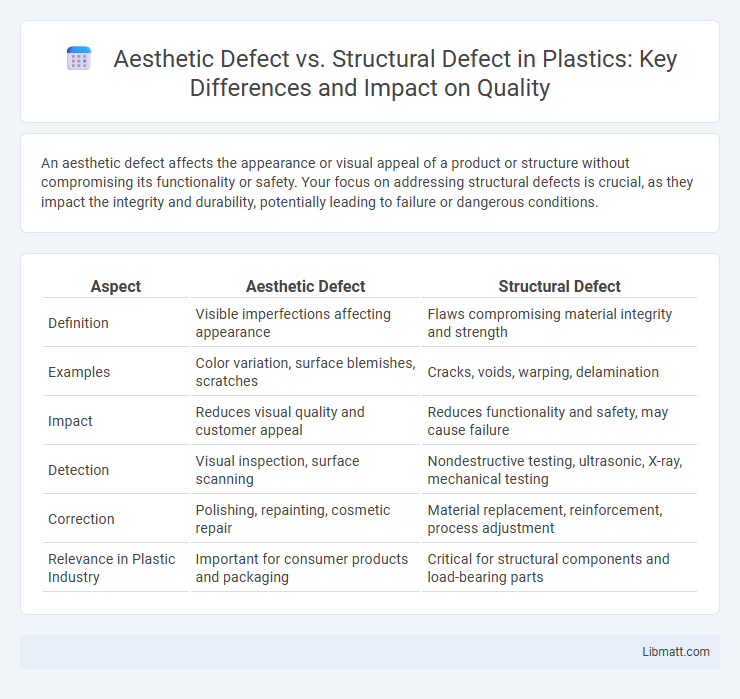An aesthetic defect affects the appearance or visual appeal of a product or structure without compromising its functionality or safety. Your focus on addressing structural defects is crucial, as they impact the integrity and durability, potentially leading to failure or dangerous conditions.
Table of Comparison
| Aspect | Aesthetic Defect | Structural Defect |
|---|---|---|
| Definition | Visible imperfections affecting appearance | Flaws compromising material integrity and strength |
| Examples | Color variation, surface blemishes, scratches | Cracks, voids, warping, delamination |
| Impact | Reduces visual quality and customer appeal | Reduces functionality and safety, may cause failure |
| Detection | Visual inspection, surface scanning | Nondestructive testing, ultrasonic, X-ray, mechanical testing |
| Correction | Polishing, repainting, cosmetic repair | Material replacement, reinforcement, process adjustment |
| Relevance in Plastic Industry | Important for consumer products and packaging | Critical for structural components and load-bearing parts |
Understanding Aesthetic vs Structural Defects
Aesthetic defects refer to surface-level imperfections such as scratches, discoloration, or uneven finishes that do not compromise the functionality or safety of a product or structure. Structural defects involve fundamental flaws in design, materials, or construction that can weaken integrity, leading to potential failure, safety hazards, or significant repair costs. Differentiating between these defects is crucial for prioritizing repairs, maintaining safety standards, and ensuring accurate warranty claims or insurance assessments.
Definition of Aesthetic Defects
Aesthetic defects refer to imperfections that affect the appearance or visual appeal of a product, structure, or material without compromising its functionality or structural integrity. These defects include issues such as discoloration, surface blemishes, scratches, or uneven finishes that are noticeable but do not impair performance or safety. Aesthetic defects primarily impact the cosmetic value and user satisfaction rather than the durability or operational capability of the item.
Definition of Structural Defects
Structural defects refer to significant flaws in a building's essential framework, such as foundations, load-bearing walls, beams, or columns, which compromise the stability and safety of the entire structure. These defects can result from poor design, faulty construction, material failure, or environmental factors and typically require urgent remediation to prevent further damage or collapse. Understanding the definition of structural defects helps you differentiate them from aesthetic defects, which primarily affect appearance rather than safety or functionality.
Common Causes of Aesthetic Defects
Common causes of aesthetic defects include surface scratches, discoloration, uneven finishes, and misalignments during manufacturing or installation processes. Poor material selection, inadequate curing or drying times, and environmental exposure such as moisture or UV radiation often contribute to these visible imperfections. These defects affect the appearance but do not compromise the overall structural integrity of a building or product.
Common Causes of Structural Defects
Structural defects commonly arise from poor construction practices, including inadequate foundation design, use of substandard materials, and improper load distribution. Environmental factors such as soil movement, water damage, and natural disasters also contribute significantly to structural issues. Your understanding of these causes helps distinguish critical repairs from cosmetic fixes related to aesthetic defects.
How to Identify Aesthetic Defects
Aesthetic defects are surface-level issues that affect the visual appeal of a product, such as scratches, discoloration, or uneven finishes, and can be identified through close visual inspection under proper lighting conditions. Unlike structural defects that compromise functionality or safety, aesthetic defects do not impair performance but can influence customer satisfaction and perceived quality. You should carefully examine the item's exterior and compare it against quality standards or reference samples to effectively spot any cosmetic imperfections.
How to Identify Structural Defects
Structural defects can be identified by examining key indicators such as significant cracks in load-bearing walls, uneven floors, and doors or windows that fail to close properly. Signs of foundation problems like sinking or shifting, visible deterioration in beams or columns, and water damage affecting support elements also suggest structural issues. Professional assessment using tools like moisture meters and structural engineering analysis is essential to accurately diagnose these defects and distinguish them from purely aesthetic imperfections.
Impacts of Aesthetic and Structural Defects on Property Value
Aesthetic defects, such as peeling paint or outdated fixtures, primarily affect the property's visual appeal and can reduce marketability, potentially lowering offers by 5-10%. Structural defects, including foundation cracks or compromised roofing, pose significant safety risks and often necessitate costly repairs, leading to value reductions of 20% or more. Both defects influence buyer perception, but structural issues have a far greater impact on property value and insurability.
Repair and Remediation Approaches
Aesthetic defects typically require surface-level repair methods such as repainting, refinishing, or patching to restore visual appeal without affecting structural integrity. Structural defects demand more extensive remediation, including reinforcement, underpinning, or full component replacement to ensure safety and longevity. Your remediation strategy should align with the defect type to optimize both cost-effectiveness and functional outcomes.
Legal and Warranty Considerations
Aesthetic defects typically involve surface imperfections that do not compromise the safety or functionality of a product, often excluded from warranty coverage, while structural defects affect the integrity and performance, triggering legal obligations and warranty claims. Your warranty rights usually emphasize repair or replacement for structural defects, with manufacturers liable under product liability laws if such defects cause harm. Understanding the distinction helps you enforce correct legal remedies and warranty benefits for defects impacting usability versus appearance.
Aesthetic defect vs structural defect Infographic

 libmatt.com
libmatt.com